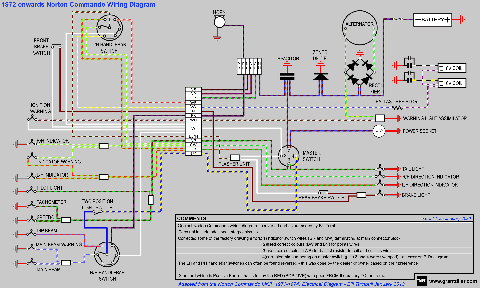I have a Mk 1 Commando 850 and have noticed a white/light purple wire, which when traced, is attached to the ballast resistor the other end could possibly go to the ignition switch, (it's dangling in that kind of position) , I've owned the bike for 3 years and assume it hasn't been connected, the bike is on points and has 6 volt coils.
Does anyone know where it should be connected and what damage it could cause if left disconnected
Don't remember a white…
- Log in to post comments
Yes...
On all but the pre-1971 bike (which had 12 volt coils) you should indeed have a WP (white/purple) wire!
Assuming you are still on points, and they have not been replaced by electronic ignition, your ballast resistor is fed by a WU (white/blue) wire that meets in a connector with the WY (white/yellow) that is the kill switch on your handlebars.
The WP (white/purple) comes out of the ballast resistor and feeds the negative side of each ignition coil.
The ballast resistor is there so that six volt coils can be used instead of twelve volt ones.
The ballast resistor is dropped (along with the condensers) when you move to electronic ignition, as the two six volt coils are wired in series and fire together, as most ignitions are wasted spark.
Here is a diagram showing the correct wires and colours (it is not labelled up on the factory workshop diagram)
- Log in to post comments
Agreed Grant. But the…
Agreed Grant. But the ballast resistor lives next to the coils and the link wire (white/purple) is very short. Certainly doesn't extend back to the ignition switch. So yes, the ballast resistor should connect to the coils, bike isn't going to run otherwise, but nowhere else unless there's an electric start.
But you raise a good point, OP should check that coils are 6v and use the ballast resistor if they are. But if the coils have been replaced with 12V then power (from kill switch) goes directly to the coils and the ballast and white/purple link wire can be removed.
- Log in to post comments





Don't remember a white/purple on the pre-electric start models.
But, on the 850 Mk3 there is a white/purple wire that connects the -12V from the starter solenoid directly to the coils by-passing the ballast resistor. It connects at the coil-side of the ballast resistor to feed both coils. The idea being to give the coils a bit more juice while the starter is cranking and dropping the battery voltage. And the Mk3 starter solenoid is near the battery and so the other end is close-ish to the ignition switch on earlier models.
Is it possible you have a Mk3 wiring harness? Regardless, unless you have an electric start of some type it should not be connected.